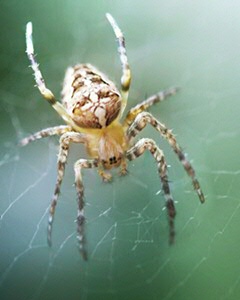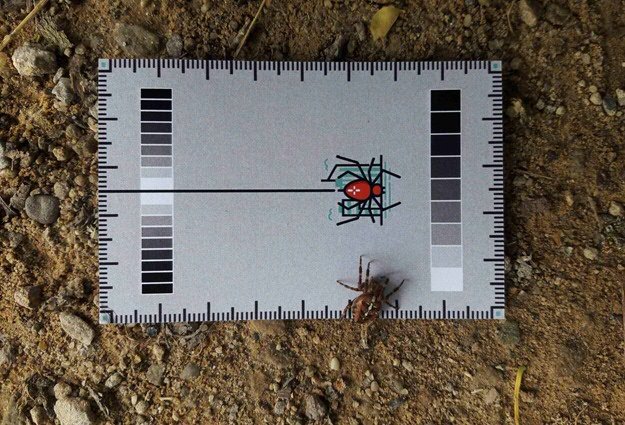What’s the difference between urban spiders and rural spiders?

Spiders. Admittedly, they’re not the most cuddly of creatures, but biologist Martine Maan hopes that plenty of people will be willing to help her with her research into them by taking part in a CurioUs measuring survey. There is definitely a difference between urban spiders and rural spiders. And Maan wants to find out more.
So, urban spiders are different from rural spiders. What are these differences?
'Well, we suspect that they are different. The size and number of predators in cities is very different from those in urban areas. So we would expect urban spider webs to be different in size and mesh gauge. Moreover, urban spiders are likely to be bigger or smaller than rural spiders as a result of eating different food and enduring different temperatures. And they may be paler in colour, because this will protect them from over-heating in the heat of the city. Rather like the way that white cars don’t heat up as much in the sun as black cars.'
Why are you interested?
'The underlying question is whether and how plants and animals adapt to city life, and how quickly they are able to do this. Is it a matter of individual flexibility, or is evolution taking place? In other words, are changes in the genetic material being passed from generation to generation? These questions are interesting because they give insight into the impact of urbanization on other species living on our planet. This may have implications for the way we plan our cities and how we deal with plagues and invasive exotic species. In addition, the city context provides unique opportunities for fundamental research: you can use cities as laboratories with numerous replicas, which allows you to analyse whether, for example, evolution can be predicted: do organisms respond in the same way, or do they consistently find different solutions to the same problem?'
Why are you setting up a measuring survey for the public with CurioUs?
'It’s important to examine several geographical regions, to see how different (or similar) the effects are. This is why we are keen for lots of people to take part in the measuring survey, in the city and countryside, in the entire Northern Netherlands and further afield. Once we have collected enough data, we can use it as a basis for doing more experimental work in the lab and looking for a genetic basis in the variations we find.'

What do the people taking part have to measure?
'Aspects such as the length and colour of the spider and the size of the webs and the mesh. They can download the SpiderSpotter app to help them.'
It’s quite a detailed task, as you can tell from the instructions given to the participants. The wellbeing of the spider and the participants has been taken into account. "Carefully remove the spider from its web", "Wait until the spider has calmed down" and "Put the spider back in (or close to) its web" are just a few of the instructions. And because not everyone is keen on spiders: "It can help to work in pairs. The bravest person can hold the card next to the spider, while the other one takes the photo."
Are you doing this because you want the extra help, or to raise awareness of spiders, or to involve the public in science?
'I enjoy showing people what science is all about, helping them to understand the process of evolution, and opening their eyes to everything that is going on around them. You don’t have to travel to far-away places, or watch BBC documentaries to see wonderful or exciting natural phenomena. You might find spiders a bit scary at first, but if you observe them for a while, you’ll start to appreciate their beauty and fascination. In fact, you might even feel less scared. My ultimate hope is that people will take better care of their natural environment.'
Martine Maan is studying the behaviour, ecology, and evolution of animals at the UG’s GELIFES research institute (Groningen Institute for Evolutionary Life Sciences). The emphasis of her research and teaching is on the impact of individual behaviour on evolutionary processes, and the evolution of behaviour itself.
CurioUs is an initiative of Science LinX (University of Groningen, Faculty of Science and Engineering), Forum Groningen, and the Aletta Jacobs School of Public Health. CurioUs hopes to organize various activities to whet the appetites of inquisitive northerners and encourage them to get involved in science and technology so that they can study, understand, and improve their own living environment.
| Last modified: | 27 September 2021 11.56 a.m. |
More news
-
03 April 2025
IMChip and MimeCure in top 10 of the national Academic Startup Competition
Prof. Tamalika Banerjee’s startup IMChip and Prof. Erik Frijlink and Dr. Luke van der Koog’s startup MimeCure have made it into the top 10 of the national Academic Startup Competition.
-
01 April 2025
NSC’s electoral reform plan may have unwanted consequences
The new voting system, proposed by minister Uitermark, could jeopardize the fundamental principle of proportional representation, says Davide Grossi, Professor of Collective Decision Making and Computation at the University of Groningen
-
01 April 2025
'Diversity leads to better science'
In addition to her biological research on ageing, Hannah Dugdale also studies disparities relating to diversity in science. Thanks to the latter, she is one of the two 2024 laureates of the Athena Award, an NWO prize for successful and inspiring...
